Volatility Ruled Crypto Markets in 2021, From $69K Bitcoin to Elon Musk’s ‘Dogecoin to the Moooonn’
It was another characteristically unpredictable year in cryptocurrency markets.
Bitcoin staged a powerful rally to start off 2021, punctuated by tweets from the billionaire Tesla founder Elon Musk that sent prices soaring for the joke token dogecoin. Soon, though, China’s crackdown on cryptocurrency mining and increasingly nagging concerns over the Bitcoin blockchain’s environmental footprint cast a pall over the market. Instead, crypto traders aped into all sorts of bets on NFTs, video game-linked tokens like Axie Infinity’s AXS and up-and-coming blockchains like Solana and Terra. (Were they fads or a technological revolution?) El Salvador adopted bitcoin as legal tender, and the largest cryptocurrency eventually hit a new all-time high around $69,000. But by the end of the year it was clear bullish traders wouldn’t realize the (widely predicted) dream of a $100,000 print.
We’ve assembled a chronological rundown of the most salient moments in crypto markets in 2021 – highlighting key lessons and takeaways from this fast-evolving corner of global finance. Warning: There will be volatility.
Bitcoin Starts Off in a Frenzy

Bitcoin (BTC) started 2021 on a strong note, gaining nearly 40% during the first week of January and surging to a new all-time high of around $40,000.
It was such a powerful and explosive rally – and, yes, cryptocurrency volatility is the norm – that not everyone was convinced the rally could be sustained.
Retail traders piled in, while some institutional investors started to raise concerns about rampant speculation. After all, bitcoin had traded as low as $3,850 as recently as the prior year,
Demand from institutional investors was said to have been the cause for the astronomical rise of the top cryptocurrency by market capitalization in the fourth quarter of 2020, when Paul Tudor Jones, Stanley Druckenmiller and MicroStrategy said they had jumped into the market.
In December of that year, Jeff Dorman, chief investment officer at crypto asset management firm Arca, told CoinDesk that “there is a good chance that actively managed hedge funds and passive indexes built around high allocations to bitcoin have a very short shelf life.”
Bitcoin quickly advanced from $30,000 to $40,000 within the first five trading days of January – an impressive gain that fueled even more market excitement.
The sharp price rise in BTC contributed to a $1.1 billion profit for Ruffer Investments, a U.K.-based investment management firm, in just five months. By June, Ruffer stated that a “speculative frenzy” in cryptocurrencies forced the firm to exit its bets on further gains.
And Ruffer wasn’t alone in its concern about market exuberance. Volatile price swings caused other institutional investors to doubt a prolonged crypto rally.

Scott Minerd, chief investment officer at the Guggenheim global investment firm, said he didn’t believe bitcoin’s investor base was “big enough” or “deep enough” to keep prices at current levels.
“Right now, the reality of the institutional demand that would support a $35,000 price or even a $30,000 price is just not there,” he said.
Around the same time, a JPMorgan analyst said a bearish outlook could emerge if bitcoin failed to claw its way back over $40,000, leading to steeper losses over the ensuing weeks.
The price was going up, but it all seemed like a lot of speculation. How long could the rally last?
A few funds established bitcoin positions but didn’t “hold on for dear life” – a commonly misconstrued back formation of the crypto-jargon term “HODL,” which originally appeared as a fast-typing (or maybe drunk?) person’s attempt to type the world “hold.”
Musk pumps bitcoin and dogecoin

As bitcoin (BTC) soared in February, social media, particularly Twitter, appeared to take on an expanded role in cryptocurrency markets, with prices jumping in response to tweet after tweet. It became clear that investor appetite for risk remained strong despite earlier concerns about rampant speculation.
A series of posts by Tesla CEO Elon Musk and then-Twitter CEO Jack Dorsey helped to push bitcoin higher from $40,000 in January to nearly $57,000 in February. The viral effects of social media pushed retail traders into full-on buy mode, with bones thrown to the doggy-themed joke token dogecoin (DOGE) that added billions of dollars to that cryptocurrency’s market value.
On social media, some traders banded together in an effort to keep crypto prices elevated – similar to the way retail traders in traditional markets had coordinated to roil stocks like GameStop.
For example, Musk, ranked by Forbes as the world’s richest person, added the #Bitcoin hashtag to his Twitter profile, contributing to an immediate 11% BTC price rally. Shortly afterward, Dorsey also added the #Bitcoin hashtag to his Twitter profile.

The bitcoin endorsements by Musk and Dorsey went viral, inspiring a league of traders who dismissed the cautionary warnings of more experienced investors. It all seemed like a lot of fun. (”Laser eyes” became a thing.) And bitcoin was not the only cryptocurrency to advance.
Musk also suggested in a tweet that dogecoin might be “the future currency of earth.” Musk’s involvement in the dog token tribe helped send DOGE moooonning (his word), along with other alternative cryptocurrencies.
The future currency of Earth
— Elon Musk (@elonmusk) February 6, 2021
Such hijinks kept the crypto party going. Here’s a look at relative performance in January; DOGE vastly outperformed bitcoin in January, as shown below:
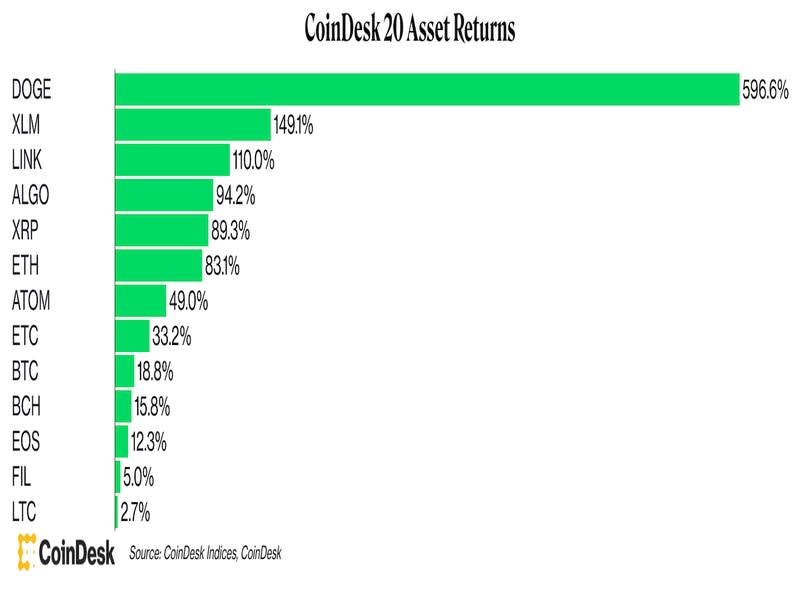
How could one man cause such a massive move in crypto markets?
CoinDesk’s Edward Oosterbaan explained earlier this month how Musk’s star power was able to sway the price of BTC and DOGE. (Spoiler alert: None of this is all that deep.)
“Musk is far from the only person to move the crypto market for no apparent reason other than making an endorsement,” Oosterbaan wrote. “A sizable portion of the industry from meme coins to NFTs has proven to be highly responsive to celebrity shilling.”
Oosterbaan continued: “High-profile celebrities and Twitter accounts sowing FOMO (fear of missing out) are likely here to stay. The power of social media in the crypto market is testament to the general lack of regulation and maturity, and the inherent liquidity of 24/7, permissionless assets.”
The chart below tracks Musk’s influence on the DOGE price over time, using data from TradingView.
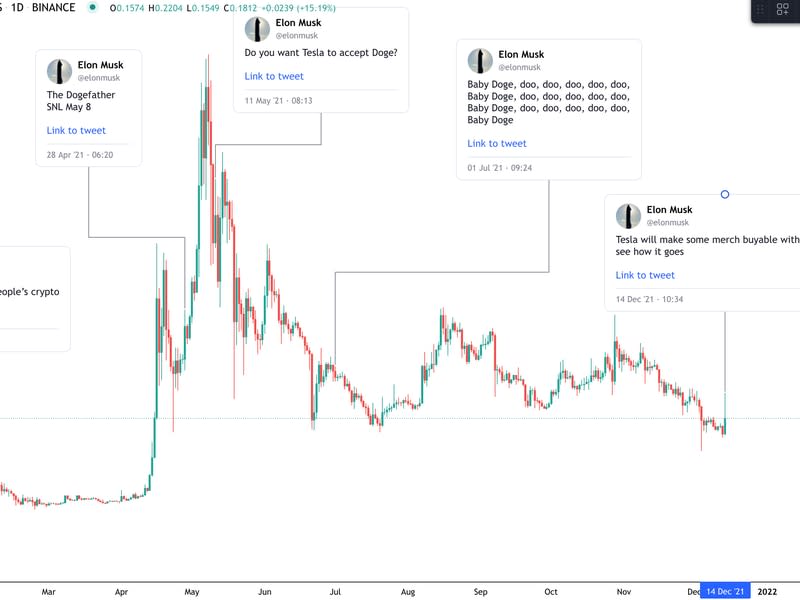
During bitcoin’s swift ascent in January and February, retail traders used social media as a gateway to discover new alternative cryptocurrencies and react to market sentiment in real time.
In just a few tweets, Musk and other popular figures were able to pump and dump coins, leading to significant price gains and losses.
The lesson of this ever-so-bizarre stretch of crypto markets history is that social media was, and still is, a force that’s impossible for traders to ignore.
From Tesla to Coinbase, bitcoin went up, then down

The bitcoin price broke above $50,000 in February after Tesla disclosed it had invested $1.5 billion into BTC.
The market reaction inspired a bit of opportunism on the part of one enterprising T-shirt vendor, who rushed to offer a T-shirt for $19.99 with the words “Elon’s Candle,” referring to the electric vehicle maker’s billionaire CEO.
The “candle” referred to the dramatic pattern that appeared on bitcoin’s price chart as a result of the Musk-fueled price pop:

In March, Musk ratcheted up the drama with a tweet stating that consumers can “now buy a Tesla with bitcoin.”
You can now buy a Tesla with Bitcoin
— Elon Musk (@elonmusk) March 24, 2021
The announcements helped propel bitcoin, the oldest cryptocurrency, toward a previously unthinkable $1 trillion market capitalization for the first time.
But from a professional price chart reader’s perspective, bitcoin appeared to be “overbought;” that term meant the market’s run-up had probably gone too far, too fast and wasn’t justified by the underlying level of buying interest at the new, elevated threshold.
Once again, bitcoin turned lower – dropping back to its 50-day moving price average of around $30,000. Apparently, it was a level where buyers once again appeared to grow interested.
The market stabilization offered a signal to traders: Bitcoin appeared to hold above the price where it had started 2021, at $29,112. That was cause for renewed optimism.
So as news headlines in traditional financial media and breathless commentators began to highlight the upcoming direct stock listing of Coinbase, the biggest U.S. cryptocurrency exchange, the bitcoin rally resumed.
Over the coming months, the price would more than double, a reminder of just how volatile cryptocurrency markets can be.
Coinbase stock goes public

On April 14, Coinbase, the largest U.S. cryptocurrency exchange, went live with its direct stock listing on the Nasdaq exchange, under the ticker symbol COIN.
“This is a watershed moment for the digital-asset industry, as it signifies a larger moment of credibility for a market that is maturing rapidly,” Hunter Merghart, head of U.S. for rival cryptocurrency exchange Bitstamp, told CoinDesk in an interview.
The initial trading price for the COIN stock, at $381, was an impressive 52% above the reference price of $250 a share published a day earlier by the Nasdaq. But even that lofty price level was well below some of the price targets issued recently by stock analysts, with some estimates ranging as high as $600 a share.
The failure of COIN shares to push even higher suddenly seemed, well, deflating for a crypto market that had grown accustomed to prices constantly going higher.
By the end of the first day of trading, COIN’s stock price had dropped to $342.
I was gonna buy $COIN at $250 earlier but ended up not doing it. Probably a good idea as it is likely going to drop to under $200 in the next few weeks.
— Sauce (@RichBankerDude) April 14, 2021
The fading spirits spilled over into the bitcoin market: It turned out the hotly anticipated public trading debut of the cryptocurrency exchange wasn’t enough to sustain the twofold price rise in BTC over the prior couple of months.
Bitcoin stalled near an all-time high of around $64,800 on April 14 and quickly went into a sharp sell-off. The chart below shows slowing price momentum, defined by lower highs in the daily relative strength index (RSI), which typically precedes a decline in price:

The COIN direct listing ended up being a classic “buy-the-rumor, sell-the-fact” event. In hindsight, the date of the Coinbase initial public offering would precisely coincide with bitcoin’s top.
For seasoned crypto traders and newbies alike, the episode offered a fresh lesson in how even sky-high price predictions, euphoric rallies and milestones like the Coinbase direct stock listing do eventually come head to head with the reality of fickle and notoriously cryptocurrency markets, and down-to-earth valuations.
Remembering Bitcoin’s Crash of 2021

Some traders and investors began to cash out in April and May as concerns mounted over U.S. capital gains taxes, bitcoin’s environmental footprint and an outright crypto ban in China. It seemed like the fear, uncertainty and doubt – FUD, or crypto-speak for negative news – was coming all at once.
All it took was a New York Times headline in mid-April that U.S. President Joe Biden was planning to roughly double the tax on capital gains or proceeds earned from selling assets – with provisions deemed unfriendly toward cryptocurrencies – to end hopes of a rally back toward bitcoin’s all-time high near $65,000. After a powerful bull run earlier in the year, bitcoin’s price decline suddenly accelerated.
“The cryptocurrency was already on the defensive,” Pankaj Balani, co-founder and CEO of the Singapore-based Delta Exchange, told CoinDesk in an email at the time. “The tax news invited more profit taking.”
“The U.S. actions were not bullish for bitcoin, as tax increases could be a thorn in the recovery and will drag down investments,” Edward Moya, an analyst at Oanda, a foreign exchange brokerage firm, wrote in an email.
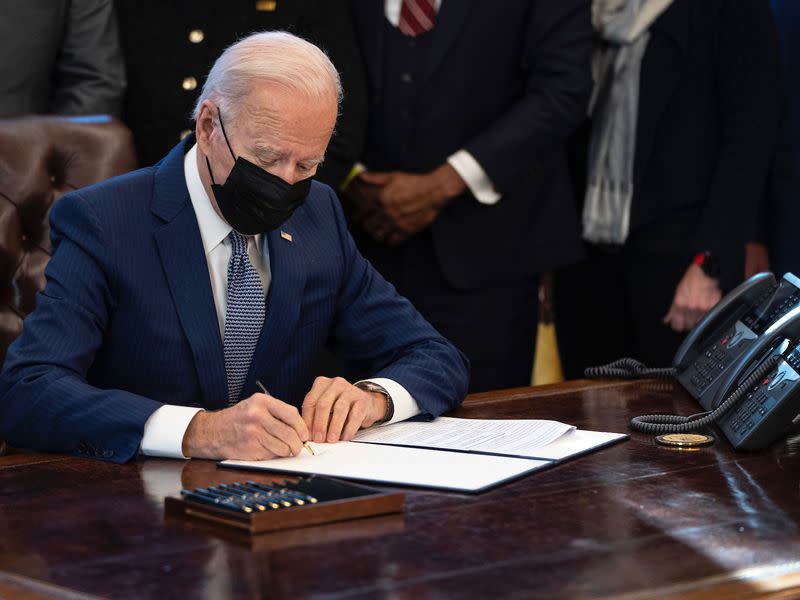
Some analysts pointed to a stronger U.S. dollar as a potential headwind for bitcoin. Warmer weather was coming in the Northern Hemisphere, and more coronavirus vaccines were getting distributed around the world, leading to a sunnier economic outlook. It appeared as though the U.S. was on its way to improving the budget deficit, which widened during the pandemic stimulus program.
All that meant there might be less need for extra economic support from governments and central banks, which had bolstered bitcoin’s attractiveness among investors as a possible hedge against fast inflation.
Musk raises environmental concerns
But bitcoin had other problems. In the months ahead, many investors in traditional markets – perceived as a key target for mainstream cryptocurrency adoption – would start to question the cryptocurrency’s environmental footprint – due to the blockchain network’s heavy electricity usage.
Musk, for example, made a U-turn from his earlier bullish stance on bitcoin and decided to no longer accept BTC as payment for his company’s electric cars, citing concerns about the use of fossil fuels in crypto mining.
Tesla & Bitcoin pic.twitter.com/YSswJmVZhP
— Elon Musk (@elonmusk) May 12, 2021
Musk’s tweet triggered an immediate 6% drop in the bitcoin price. Suddenly, the environment became front and center as an impediment in the 12-year-old cryptocurrency’s path to becoming a widely acceptable asset class.
And with environmental, social and governance (ESG) becoming the new buzzwords on Wall Street, it became harder to convince big money managers that energy-intensive bitcoin was a good addition to portfolios.
For example, a survey of 600 people in the fund management industry found that 96% expected their firms to increase prioritization of ESG during 2021. John Reed Stark, former chief of the U.S. Securities and Exchange Commission’s Office of Internet Enforcement, told CoinDesk’s Lyllah Ledesma in May that the bitcoin ESG concerns would certainly damp institutional investment in crypto.
China bans crypto

And just when bitcoin traders thought they had seen enough of the fear, uncertainty and doubt, China officially banned all financial institutions and payment companies from providing services related to cryptocurrency transactions.
China had been banning things related to crypto since 2013, but the fresh crackdown made it clear that crypto trading activity involved “legal risks” and that “any legal person, unincorporated organization or natural person” investing in virtual currency and related derivatives was violating “public order and good customs,” CoinDesk’s Muyao Shen reported.
News of the China ban sent bitcoin sharply lower, which left the price down roughly 50% from the April record near $65,000. By almost any definition, the bitcoin market had entered a new, bearish phase.
The China-related sell-off wiped $400 billion off the crypto market, which encouraged some “whales” – large BTC holders – to move their coins to exchanges for sale. Crypto markets were in panic mode.
It also dawned on investors just how vulnerable cryptocurrencies were to regulatory risk. Whether it was concerns about capital gains taxes or the outright crypto ban in China, bitcoin’s euphoric rise appeared stunted by the increased scrutiny from governments and supervisors of the traditional financial system.
More work would be needed before environmentally conscious investors would start piling into bitcoin.

Ruffer Investments cashes out
Ruffer Investments was one of the earliest big institutional investors to bet on bitcoin – starting in November 2020.
As prices shot up during early 2021, Ruffer essentially rode the wave while other fund managers were just warming up to crypto, lured by its potential for high returns.
“Last November we gained exposure to bitcoin. We viewed it as an option on an emerging store of value with a highly skewed and attractive risk/reward profile,” Duncan MacInnes, investment director at Ruffer Investments, wrote in a blog post on July 9.
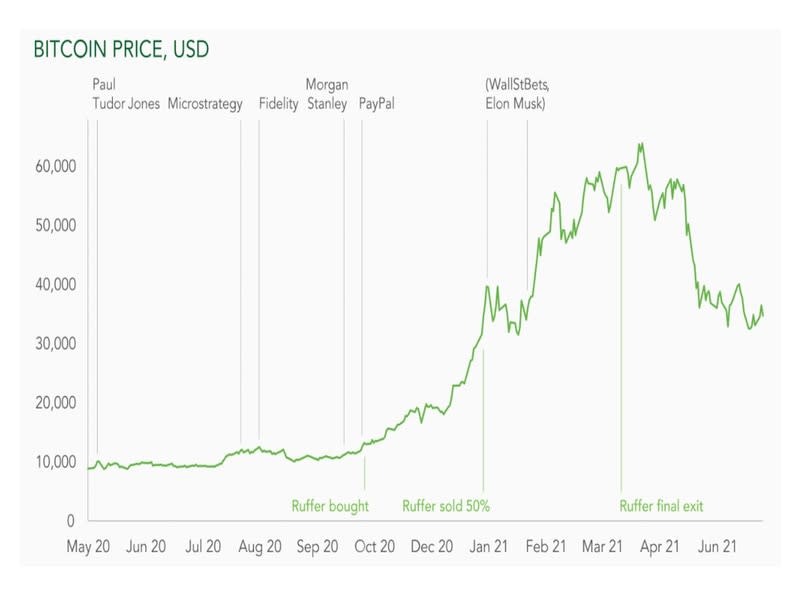
But even Ruffer was taken aback by the ferocity of bitcoin’s price rally at the start the year to a new all-time high of around $65,000. And Ruffer cashed out. The market seemed to be unsustainable.
“In 2021, the excitement is in cryptocurrencies and decentralized finance. The promise is real. But so, too, is the surge in excess liquidity generated by fiscal stimulus and ongoing quantitative easing. Excess liquidity looked to us to be peaking in April,” MacInnes wrote.
The Sunday Times reported in June that Ruffer made a $1.1 billion profit in five months.

Extreme bullish sentiment
In terms of the market reversal, it sure didn’t help that several crypto-market indicators were flashing signs of excessive buying activity in the month or so leading up to bitcoin’s April price peak. For example, around March, Alternative.me’s Crypto Fear & Greed Index reached its highest level since June 2019, which had preceded a nearly 60% BTC price sell-off.
There were other warning signs in both blockchain data and price charts. (See the chart below, which looks at technical indicators on bitcoin’s “market value to realized value” ratio, a blockchain-based market metric known as MVRV.)
Crypto industry responds to ESG concerns
As nagging environmental concerns over bitcoin’s environmental footprint continued to weigh on the market, crypto-industry executives took steps to respond.
Musk, the billionaire, whose market-moving tweets earlier in the year revealed an on-again, off-again infatuation with bitcoin, sounded a fresh openness to crypto industry dialogue over the Bitcoin blockchain’s electricity usage.
Toward the end of May, the Tesla CEO tweeted that he spoke with bitcoin miners about using renewable energy resources. He wasn’t turning his back on bitcoin completely, which provided some hope for discouraged bulls.
Spoke with North American Bitcoin miners. They committed to publish current & planned renewable usage & to ask miners WW to do so. Potentially promising.
— Elon Musk (@elonmusk) May 24, 2021
The announcement on May 24 of the Bitcoin Mining Council, which banded together miners and large investors, including MicroStrategy CEO Michael Saylor, sent BTC immediately higher by almost 12%. At that point, market panic from the April sell-off began to fade, and some traders began to buy the dip.
BTC’s price eventually stabilized at about $30,000 in June as extreme selling pressure began to slow. The chart below shows the nearly 50% price drop between April and June. And then, over the course of July and August, bitcoin mostly traded sideways, establishing a new price range as some technical indicators suggested BTC’s price was oversold.
The question in the minds of crypto traders was whether the new market environment represented a pause on the way down or the foundation for a fresh leg up.
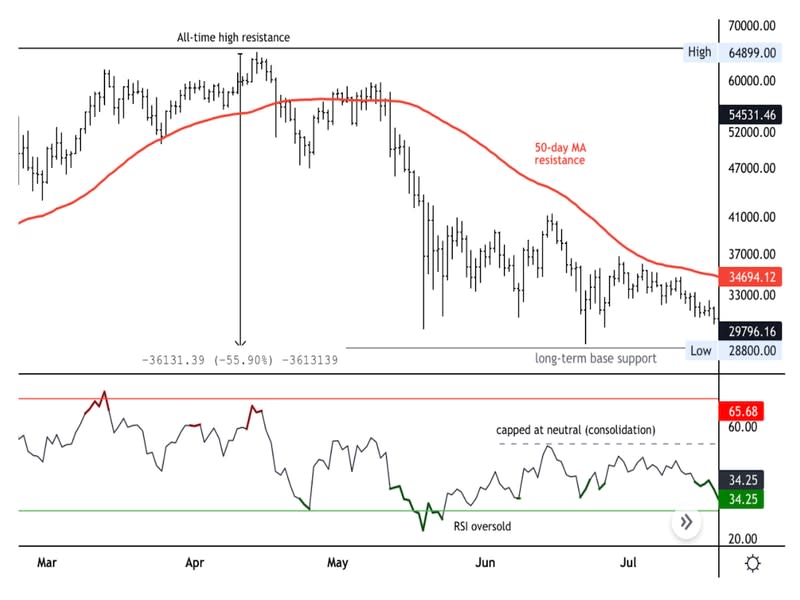
Price movements were far less volatile than they had been in recent months, and it seemed as though many investors still believed in bitcoin’s potential as a long-term store of value.
Bitcoin miners claimed to be looking for ways to reduce or mitigate their environmental footprint, and most of the network’s mining power relocated away from crypto-unfriendly China.
Plus, traders weren’t using as much leverage, and market conditions seemed to calm markedly. In other words, there wasn’t much froth.
A key takeaway was that, despite what suddenly seemed to an unrelenting onslaught of negative headlines for the bitcoin market, the price was holding up remarkably well on a historical basis: The April all-time high of around $65,000 was now looking far away, but so was the 2020 low of around $3,850.
Altcoins, NFTs Filled Void When Bitcoin Got Boring

As bitcoin’s price stabilized at around $30,000 in July and August, some traders became bored, literally.
Around the start of the year, multiple altcoins began to outperform bitcoin, reflecting a strong appetite for risk among investors. The payments token XRP rallied nearly eightfold between January and April, and the prices of many decentralized finance (DeFi) tokens such as Aave’s AAVE token and Uniswap’s UNI also soared.
Even during the broad crypto market sell-off, altcoins began to account for a greater share of the total crypto universe – shrinking bitcoin’s “dominance” in the industry jargon. Many “Ethereum killers,” or competitors in the field of smart contracts blockchains, began to grab the attention of traders – such as Solana, with its SOL token.
So-called layer 2 tokens such as MATIC from Polygon, which aims to increase the efficiency of transactions on the Ethereum blockchain, rose nearly twofold in July.
The chart below shows bitcoin’s market capitalization relative to the total crypto market capitalization, known as the bitcoin dominance ratio. BTC’s relative market cap loss began to accelerate between March and May before stabilizing at around 40% in the following months.
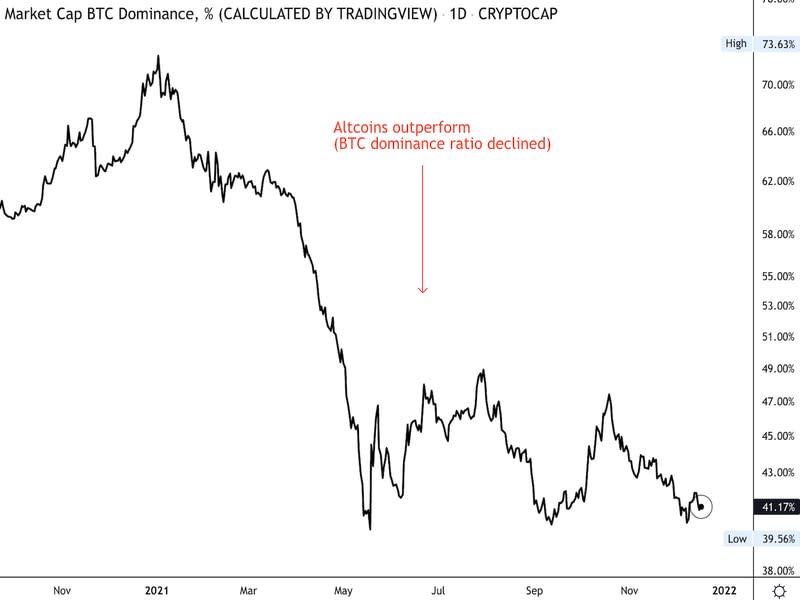
It had been clear since March just how far this year’s crypto craze extended beyond bitcoin, when a piece of digital artwork sold for $69.3 million at a Christie’s auction by crypto artist Beeple.
In the wake of breathless headlines in traditional media outlets like the New York Times, the potential riches from selling non-fungible tokens, or NFTs, attracted scores of artists, celebrities and traders seeking additional investments in the crypto market.
.@beeple 's 'The First 5000 Days', the 1st purely digital NFT based artwork offered by a major auction house has sold for $69,346,250, positioning him among the top three most valuable living artists. Major Thanks to @beeple + @makersplaceco. More details to be released shortly
— Christie's (@ChristiesInc) March 11, 2021
The Bored Apes Yacht Club became the second-most popular NFT collection by total trade volume behind CryptoPunks, CoinDesk’s Eli Tan wrote in August. At that time, the “floor price” for Bored Ape Yacht Club NFTs – the cheapest available on the open market – was 48.8 ETH, or $165,578. (By the end of the year, it would rise even further, to about $240,500.)
Owners of the high-priced NFT collection include National Basketball Association superstar Steph Curry, YouTube creator Logan Paul and musician Jermaine Dupri.
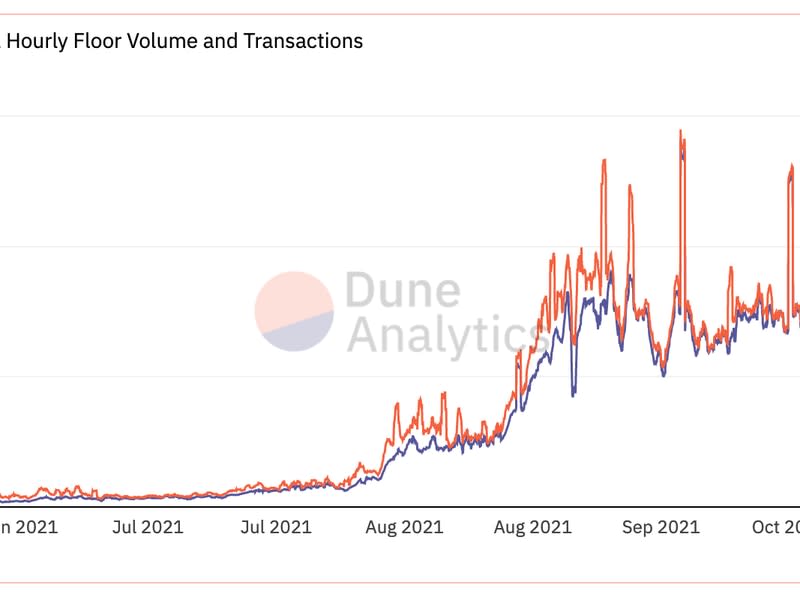
Speculation moves in cycles.
Crypto traders began the year in full buying mode and then price declines encouraged some profit-taking as regulatory risks unfolded.
The speculative wave had its ups and downs, but traders were able to find opportunities in the alternative crypto market as bitcoin began to lose its relative dominance.
And for bitcoin, an unexpected savior was about to appear.
El Salvador Bought Bitcoin, Then Bought the Dip

In June, El Salvador President Nayib Bukele, announced that bitcoin would become legal tender, making his country the first to make that move, which also meant no capital gains taxes for bitcoin holders there.
Previously, the tiny Central American country had simply used the U.S. dollar as its primary currency
1. Great weather, world class surfing beaches, beach front properties for sale.
2. One of the few countries in the world with no property tax.
3. No capital gains tax for #Bitcoin, since it will be a legal currency.
4. Immediate permanent residence for crypto entrepreneurs. https://t.co/j3eugJQCMd— Nayib Bukele 🇸🇻 (@nayibbukele) June 6, 2021
Bitcoin rose about 70% from a low of around $30,000 toward a high of nearly $50,000 in early September as traders reacted to the news from El Salvador – seen by many fans of the digital asset as a long-awaited validation of its potential to serve a global currency. El Salvador’s bitcoin’s law went into effect in September.
When the law actually took effect, bitcoin’s price began to sell off – a classic “buy-the-rumor, sell-the-fact” scenario, similar to what happened with Coinbase’s stock listing.
Bukele tweeted that El Salvador was ready to buy on price dips even as BTC continued to fall. A growing number of users on social media platforms, including Twitter and Reddit, called for people to buy small amounts of bitcoin in support of El Salvador’s bitcoin policy, Bloomberg reported. Many investors were already betting the news could give the oldest cryptocurrency a price boost.
El Salvador has just bought it’s first 200 coins.
Our brokers will be buying a lot more as the deadline approaches.#BitcoinDay #BTC🇸🇻— Nayib Bukele 🇸🇻 (@nayibbukele) September 6, 2021
On Sept. 13, software company MicroStrategy purchased an additional 5,050 BTC for about $242 million in cash. Still, BTC continued lower.
BTC declined from $50,000 toward $40,000 and ended September on a down note.
In traditional financial markets, meanwhile, concerns were growing over a possible credit default by the Chinese property developer Evergrande Group.
The creeping fears shook speculative assets including equities and cryptocurrencies; lower risk appetite among investors also contributed to bitcoin’s September slump.
The takeaway for crypto traders from the July-August price action was that El Salvador’s decision to make BTC legal tender wouldn’t be enough to keep the cryptocurrency’s price elevated at $50,000.
Bitcoin’s correlation with stocks increased along with the credit concerns emanating from China – not a good thing, since stocks were going down.
Still, the nearly 7% BTC drop in September looked far less severe than the 50% price crash in April and May. After some ups and downs, bitcoin’s price had again stabilized at well above 2020 levels as some traders began to anticipate a $100,000 BTC price by year end.
Bitcoin ETF Rally Proved Short-Lived, and $100K Dreams Faded

The September dip didn’t last long.
The market got a fresh jolt of enthusiasm when the first U.S. bitcoin exchange-traded fund – a bitcoin futures ETF, that is – launched in the fourth quarter. Bitcoin climbed from $40,000 toward $65,000 in October, spurring visions of $100,000 by the end of the year.
After months of delays, U.S. Securities and Exchange Commission (SEC) Chairman Gary Gensler announced in August his preference for a bitcoin futures-based ETF. Traders became hopeful that the SEC would approve a bitcoin-linked ETF in October.
Lurking behind those hopes was the belief that many investors in traditional markets wanted to bet on bitcoin but lacked the technological setup or know-how to do so; an ETF would let them buy into bitcoin with the ease of buying a stock in an online brokerage account.
For years, crypto industry executives had speculated that the SEC’s approval of a bitcoin ETF – denied multiple times under former SEC Chairman Jay Clayton – might finally bring about the perceived holy grail of “institutional adoption” of the cryptocurrency.
But not all bitcoin-related ETFs are created the same: A bitcoin futures ETF is backed by futures contracts such as those traded on the Chicago Mercantile Exchange. A bitcoin “spot” ETF, by contrast, is one backed directly by the cryptocurrency.
“I think his comments are pretty clear that a pure spot bitcoin ETF isn’t coming soon and that futures products would potentially be considered,” Steven McClurg, chief investment officer for Valkyrie, told CoinDesk at the time.
‘Contango bleed’ becomes the new FUD
Experts on the topic warned that a bitcoin futures ETF would be subject to disadvantages, most notably the existence of a phenomenon known as “contango bleed” or “roll costs” that would eat into investor returns.
Even so, some analysts predicted that the mere approval of a bitcoin ETF, whether spot or futures-based, would make crypto more accessible to traditional investors and thereby boost overall market sentiment.
On Oct. 15, bitcoin reclaimed the $60,000 price level as investors eagerly awaited a bitcoin ETF approval.
And on Oct. 19, the ProShares Bitcoin Strategy exchange-traded fund (NYSE: BITO), the first bitcoin futures-related ETF to trade in the U.S., went live.
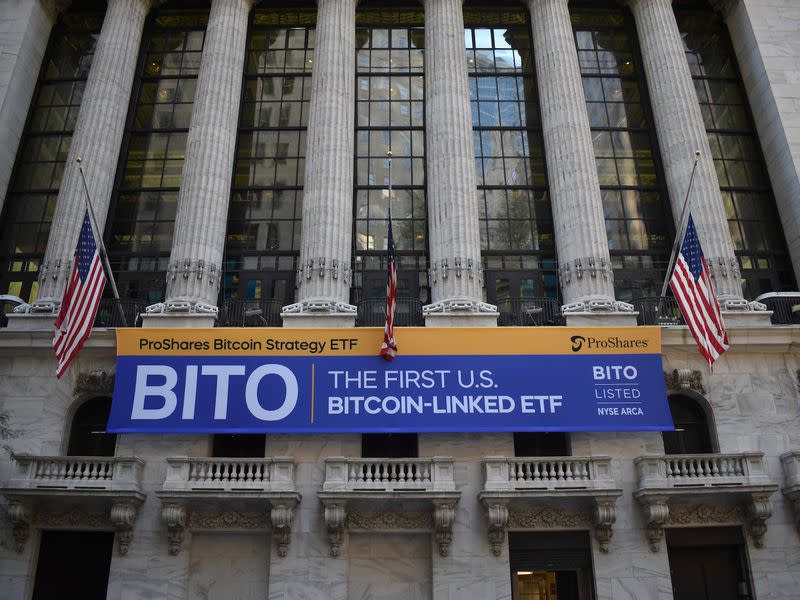
Dave Nadig, chief investment officer and director of research of ETF Trends, said that much of the volume on BITO’s first trading day appeared to come from retail investors, because there were few large “block” trades of the size that big institutional traders often deal in.
“This is probably going to be what we all expected, which is it’s an access vehicle for certain players in the marketplace,” Nadig said in a phone interview with CoinDesk at the time. “There’s lots of folks who are active participants in the markets who just don’t want to cross over the crypto bridge by themselves.”
Reality bites bitcoin
But with bitcoin already up about 40% in the first two weeks of October, some analysts began to question whether the BITO ETF was another “buy-the-rumor, sell-the-fact” event.
“Look, we’re up 40% this month, which is only 15 days old, a pause that refreshes,” Mark Yusko, CEO and chief investment officer of Morgan Creek Capital Management, said during a CNBC interview on Oct. 17. “Given how overbought we are right now,” Yusko said, a fresh sell-off “wouldn’t surprise me.”
Crypto bulls weren’t done yet. In the days following BITO’s trading debut, bitcoin continued upward to hit an all-time price high of around $69,000. Several alternative cryptocurrencies (altcoins) joined the rally. Ether, the second-largest cryptocurrency by market capitalization, rose above $4,000 for the first time since mid-May.
But as November set in, buyers failed to sustain new highs. Bitcoin began a descent below $60,000 as heavily leveraged traders began to liquidate their positions. Some indicators such as the crypto “Fear & Greed Index” showed the market in “extreme greed” territory, which typically precedes price drops, as shown in the chart below.
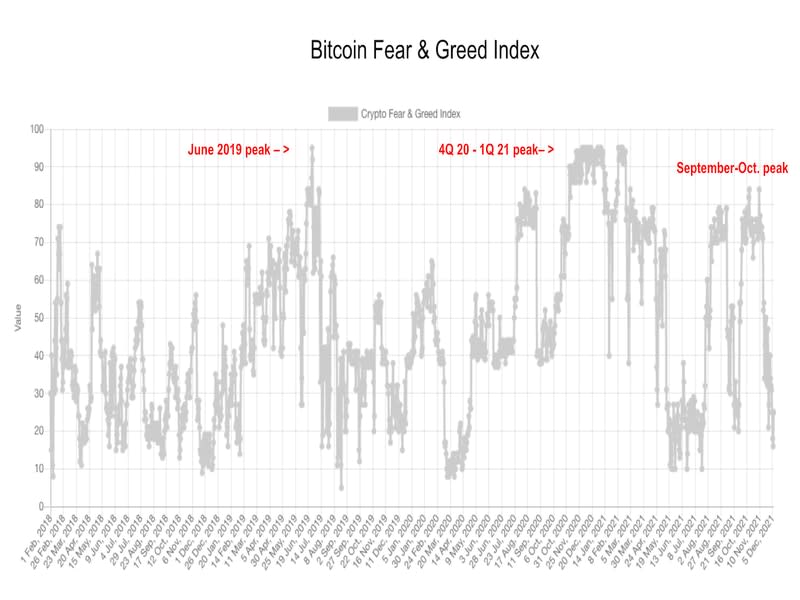
After many volatile price swings this year, bitcoin eventually stabilized at about $50,000 as of late December.
Optimistic price calls made earlier in the year, such as a prediction for $100,000 BTC by the end of year, suddenly seemed far-fetched, especially with bullish sentiment deteriorating over the past month:
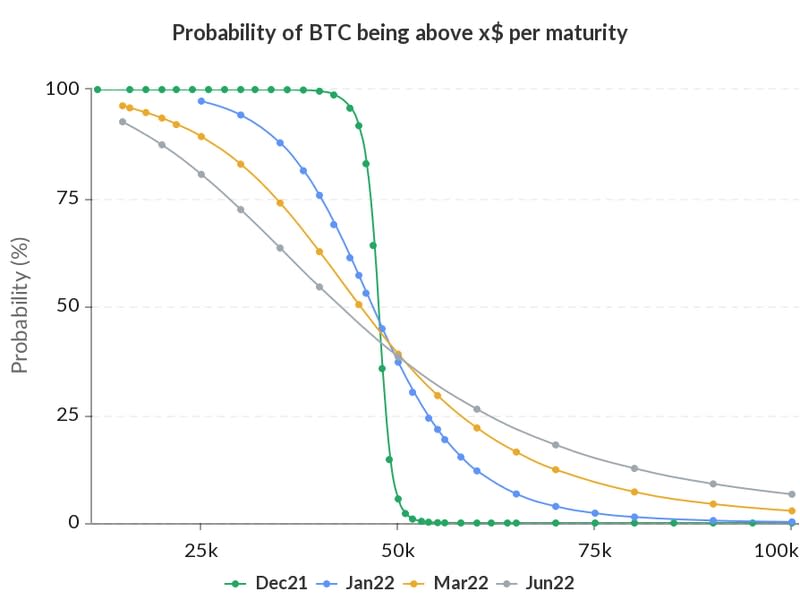
Some analysts remained hopeful of a short-term price bounce, similar to what occurred in the fourth quarter of 2020. It was not to be.
On the final day of 2021, bitcoin was changing hands around $48,000, up 63% on the year. The Ethereum blockchain’s native cryptocurrency, ether, was up five-fold to about $3,800. Solana’s SOL rose 94-fold in price and Polygon’s MATIC jumped 145-fold.
It all made the 27% year-to-date return for the Standard & Poor’s 500 Index – the benchmark for large U.S. stocks – look pretty tame.
One thing is for sure: Crypto traders are probably safe betting on another volatile ride in 2022.
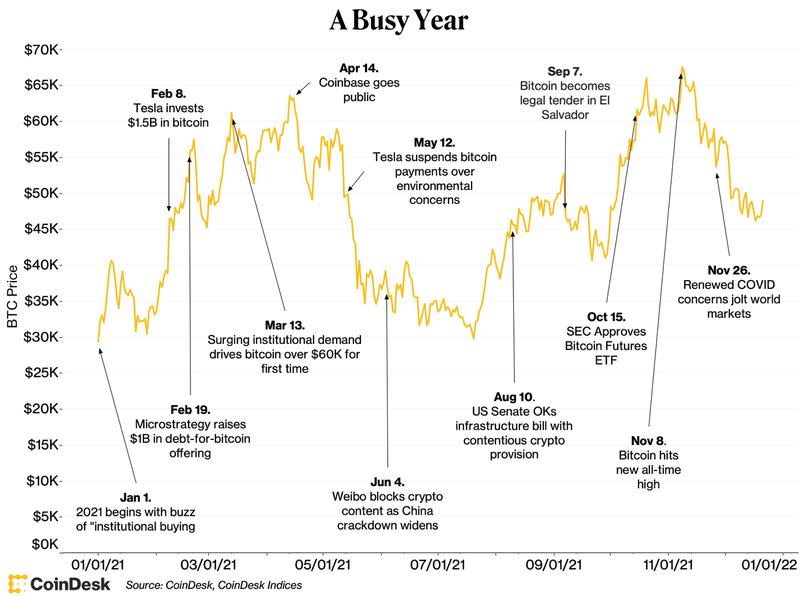
See also:
21 Predictions for Crypto and Beyond in 2022
5 Ways Money Was Reimagined in 2021
5 Ways Bitcoin’s Lightning Network Advanced in 2021
10 2022 Predictions From PwC’s Henri Arslanian

 Yahoo Movies
Yahoo Movies 
